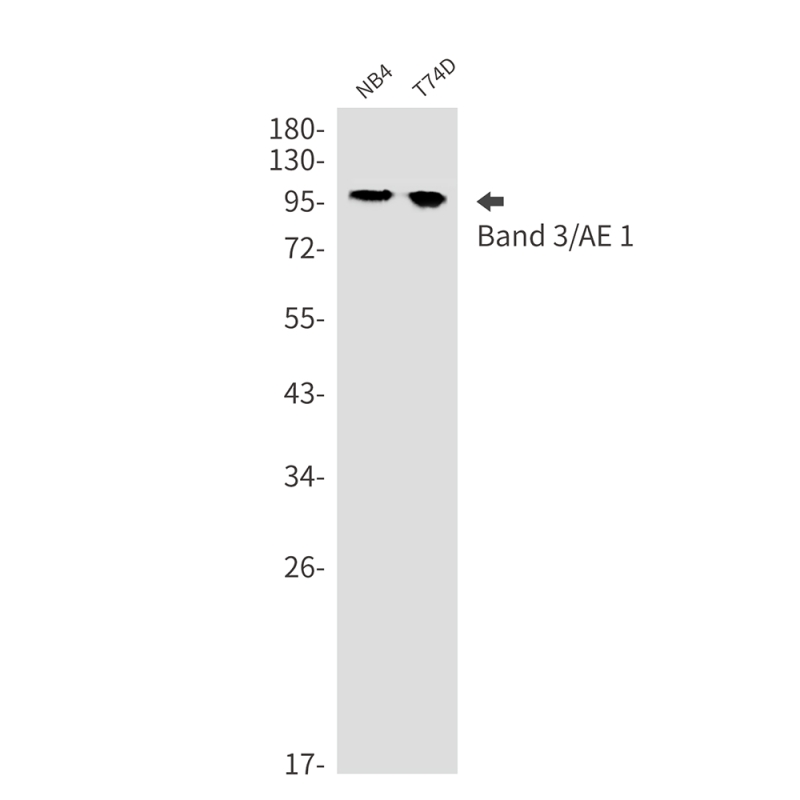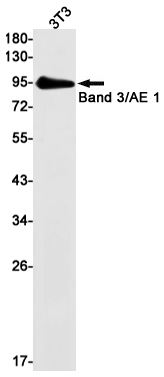

| WB | 咨询技术 | Human,Mouse,Rat |
| IF | 咨询技术 | Human,Mouse,Rat |
| IHC | 咨询技术 | Human,Mouse,Rat |
| ICC | 技术咨询 | Human,Mouse,Rat |
| FCM | 咨询技术 | Human,Mouse,Rat |
| Elisa | 咨询技术 | Human,Mouse,Rat |
| Aliases | AE1; BND3; CD233; DI; EMPB3; EPB3; FR; RTA1A; SLC4A1; SW; WD; WD1; WR |
| Entrez GeneID | 6521 |
| WB Predicted band size | Calculated MW: 102 kDa; Observed MW: 102 kDa |
| Host/Isotype | Rabbit IgG |
| Antibody Type | Primary antibody |
| Storage | Store at 4°C short term. Aliquot and store at -20°C long term. Avoid freeze/thaw cycles. |
| Species Reactivity | Human,Mouse |
| Immunogen | A synthetic peptide of human Band 3 |
| Formulation | Purified antibody in TBS with 0.05% sodium azide,0.05%BSA and 50% glycerol. |
+ +
以下是关于Band 3抗体的3篇文献概述(信息基于公开研究整理,非最新文献):
1. **文献名称**:*"Autoantibodies against erythrocyte Band 3 in autoimmune hemolytic anemia"*
**作者**:Kay, M.M. et al.
**摘要**:研究揭示了Band 3蛋白在自身免疫性溶血性贫血(AIHA)中的作用,发现患者体内产生的抗Band 3抗体会导致红细胞被巨噬细胞吞噬破坏,并探讨了抗体介导的细胞清除机制。
2. **文献名称**:*"Structural and functional alterations of Band 3 in hereditary spherocytosis"*
**作者**:Jarolim, P. et al.
**摘要**:分析了遗传性球形红细胞增多症中Band 3蛋白的突变及其对红细胞膜稳定性的影响,发现部分患者体内存在针对异常Band 3的自身抗体,加重红细胞碎裂。
3. **文献名称**:*"Band 3 clustering promotes antibody binding in malaria-infected erythrocytes"*
**作者**:Cooke, B.M. et al.
**摘要**:研究了疟疾感染后红细胞膜Band 3蛋白的聚集现象,发现这种聚集会暴露抗原表位,诱导宿主产生抗Band 3抗体,从而加剧红细胞清除和贫血症状。
注:以上文献为示例性内容,实际引用时建议通过PubMed或专业数据库核实最新研究。
Band 3 antibody targets Band 3 protein (anion exchanger 1. AE1), a transmembrane glycoprotein abundant in red blood cell (RBC) membranes. Functionally, Band 3 mediates chloride-bicarbonate exchange critical for CO₂ transport and acid-base homeostasis. Structurally, it consists of a cytoplasmic N-terminal domain binding cytoskeletal proteins (e.g., ankyrin) and a C-terminal membrane-spanning domain facilitating ion transport.
Band 3 antibodies are implicated in autoimmune hemolytic anemia (AIHA), where autoantibodies bind to Band 3. triggering RBC clearance via macrophage phagocytosis. These antibodies may recognize conformational epitopes altered during RBC aging or oxidative stress. Band 3 clustering on senescent RBCs acts as a senescence marker, promoting their removal.
In malaria, Band 3 antibodies play dual roles: *Plasmodium* invasion may involve Band 3 interactions, while host antibodies against parasite-modified Band 3 contribute to immune-mediated RBC destruction. Additionally, hereditary Band 3 deficiencies (e.g., Southeast Asian ovalocytosis) are linked to altered RBC morphology and hemolysis.
Band 3 antibodies are also research tools for studying RBC membrane integrity, ion transport mechanisms, and autoimmune or infectious pathologies. Their clinical relevance spans diagnostics (e.g., AIHA evaluation) and therapeutic research (e.g., targeting malarial vulnerabilities).
×